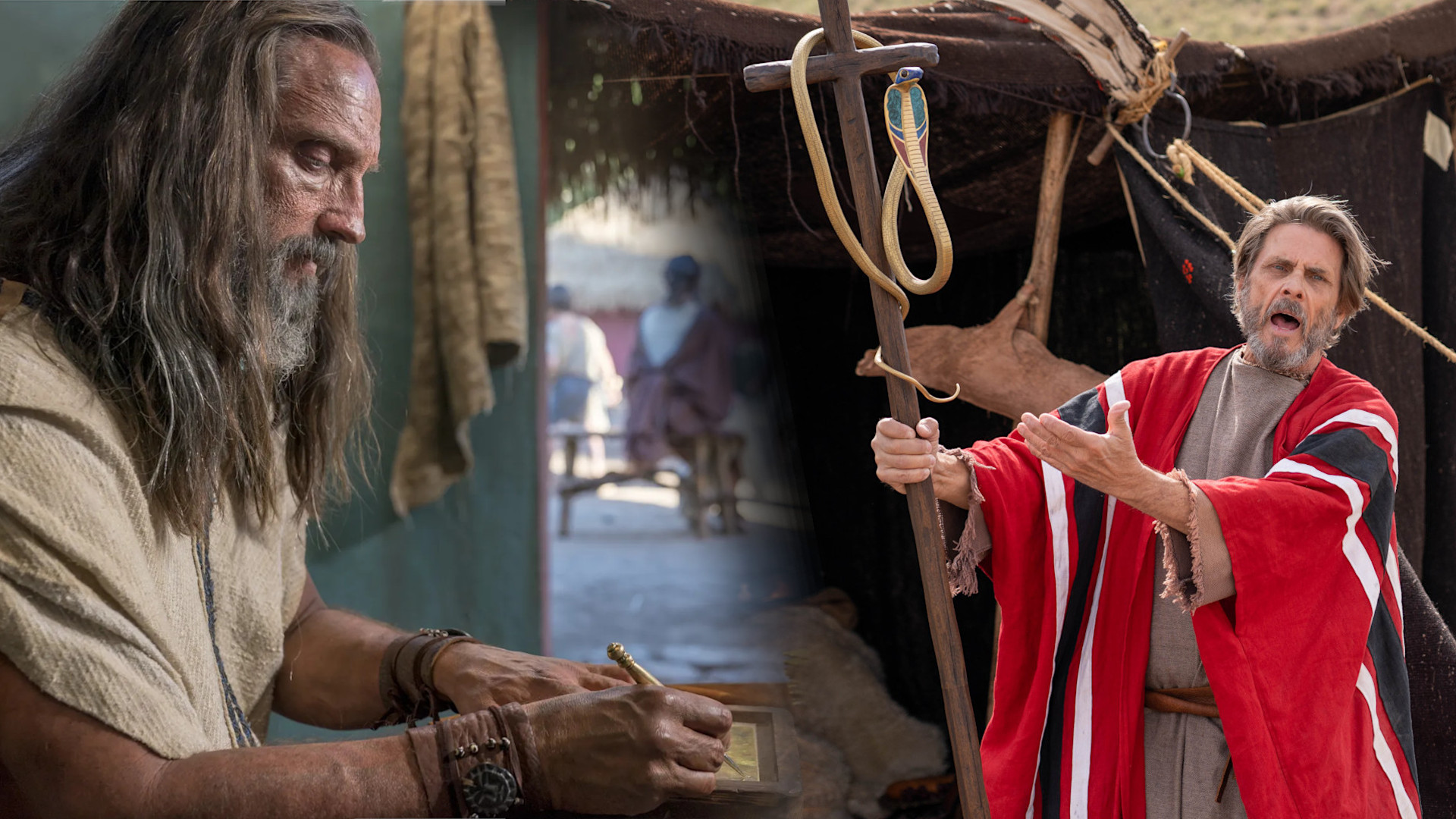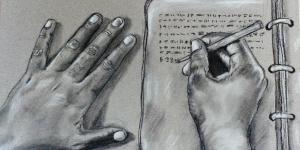You are here
How Did Nephi Liken Looking to Christ with Looking to the Brazen Serpent?

2 Nephi 25:20
The Know
Drawing on the words of his father and other past prophets, Nephi declared: “The Messiah cometh in six hundred years from the time that my father left Jerusalem; and according to … the word of the angel of God, his name shall be Jesus Christ, the Son of God” (2 Nephi 25:19).1 He then testified that just as the Lord provided the means to heal the Israelites bitten by poisonous serpents in the wilderness “if they would cast their eyes unto the serpent which [Moses] did raise up before them,” He would provide the only means of eternal salvation through “this Jesus Christ, of which I have spoken” (2 Nephi 25:20). In this way, noted S. Kent Brown, “Nephi drew attention to the link between Moses’ actions and Jesus’ atonement.”2
As Nephi then continued to testify of Christ, he spoke three times of looking to Christ in ways that are reminiscent of the Israelites looking to the brazen serpent in Numbers 21:4–9 and other ancient traditions. Matthew Scott Stenson, who has highlighted these verbal allusions to the brass serpent, observed, “Nephi … identifies and develops an intertextual comparison and type or shadow … [that] emphasizes also the importance of looking to Jesus Christ for salvation.”3 Each of these three allusions are strengthened when considered within the context of ancient Jewish and Near Eastern symbolism and traditions, as discussed below.
1. Looking forward with Steadfastness unto Christ
When the children of Israel were bitten by fiery serpents, the Lord promised that “every one that … looketh upon [the serpent of brass], shall live” (Numbers 21:8). Later Jewish traditions emphasized that it was not enough to just look with “a casual glance” but that the people had to look with “a long and insistent gaze” in order to be healed from the snake bites.4 Similarly, Nephi clearly emphasized that while his people kept the law of Moses, they “look[ed] forward with steadfastness unto Christ, until the law shall be fulfilled,” and they were thus “made alive in Christ because of [their] faith” (2 Nephi 25:24–25; emphasis added).
2. Where to Look for a Remission of Sins
In the in biblical account, the Hebrew word for “fiery serpents” in Numbers 21:6 is seraphim, and the brazen serpent is identified as a seraph in Hebrew in Numbers 21:8–9. According to LeGrand Davies, the verbal root of this word means “to burn” and primarily refers to “cleansing, purifying or refining ritual objects, people, cities, etc.” Thus, Davies has argued that the fiery serpents acted as agents of purification, cleansing the body of Israel in preparation for entry into the promised land.5 Only the people who repented and looked to the brazen serpent were healed, making it a symbol not only of healing but also of forgiveness of sin (Numbers 21:7–9).
Likewise, in Isaiah—which Nephi had just quoted—one of the angelic seraphim served a purifying role, putting a hot coal to Isaiah’s lips and declaring, “Thine iniquity is taken away, and thy sin purged” (Isaiah 6:7; 2 Nephi 16:7).6 As Krystal V. L. Pierce noted, “Here, the burning characteristics of the seraphim symbolize the purification and refinement that resulted from Isaiah’s repentance.”7
Just as the seraphim of Numbers 21 and Isaiah 6 functioned to purge individuals and communities of sin and iniquity, the early Nephites spoke of, rejoiced in, preached, and prophesied about Christ “that our children may know to what source they may look for a remission of their sins” (2 Nephi 25:26; emphasis added).
3. Looking forward to Life in Christ
As already noted, the Lord promised that “every one that … looketh upon [the serpent of brass], shall live” (Numbers 21:8). Andrew C. Skinner explained that the serpent was seen “as a bringer of salvation and giver of everlasting life” in the ancient Near East.8 Biblical scholar Victor Hurowitz argued that Numbers 21 invoked multilingual wordplays on the Hebrew words for “serpent” (nḥš) and “live” (ḥyh, ḥyy, ḥwh) and the similar sounding words for “live” and “life” in Akkadian (naʾāšu, nīšu) and “snake” in Aramaic (ḥwyʾ) to underscore the lifegiving powers manifest through the brazen serpent.9 In many ancient Near Eastern myths, serpents were symbols of life—including life after death.10
Similarly, early Nephites hoped that “by knowing the deadness of the law, [their children] may look forward unto that life which is in Christ” (2 Nephi 25:27; emphasis added). Many generations later, Nephi son of Helaman also taught, “As many as should look upon the Son of God with faith, having a contrite spirit, might live, even unto that life which is eternal” (Helaman 8:15; emphasis added). Alma likewise alluded to the account of the brazen serpent when instructing his son Helaman to “look to God and live,” adding, “If we will look, we may live forever.” (Alma 37:46–47).11 Pierce noted, “In almost every reference to the narrative [of the brazen serpent], whether Moses, Nephi, Alma, or Nephi the son of Helaman, there is an emphasis on looking to gain life.”12
The Why
The details of ancient symbolism—and particularly how that symbolism is used in the biblical account of the brazen serpent—illuminate subtle and precise ways in which Nephi is typologically relating Christ to the “the serpent which [Moses] did raise up” in the wilderness (2 Nephi 25:20). These connections were made even more explicit by later Nephite prophets, such as Nephi son of Helaman, who explained, “And as [Moses] lifted up the brazen serpent in the wilderness, even so shall he be lifted up who should come. And as many as should look upon that serpent should live, even so as many as should look upon the Son of God with faith, having a contrite spirit, might live, even unto that life which is eternal” (Helaman 8:14–15).
This link to Moses’s actions recorded in the Torah would have been an especially important and effective means of communicating to Nephi’s people why even as they kept the law of Moses, they nonetheless “look[ed] forward with steadfastness unto Christ, until the law shall be fulfilled.” It was to Christ, not the law, they could “look for a remission of their sins,” for the law itself was “deadness” except as a means of pointing people to “look forward unto that life which is in Christ” (2 Nephi 25:24–27). No symbol could have more effectively illustrated this point than the brazen serpent—a symbol that represented life and eternal life and both physical healing and spiritual purification from sin.
But like the “deadness of the law” spoken of by Nephi, the symbol of a brass serpent itself was powerless. It was not to be worshipped as an idol as if it, in and of itself, had the power to heal. It was the Lord’s power that was manifest in the healing of the Israelites, and it was ultimately because they repented and followed the Lord’s instructions that they lived (Numbers 21:7–9). Some ancient Jewish commentators as well as Christian allegorical readers understood this and reasoned that the brazen serpent was raised up on a pole as an invitation to look up toward God: “Whenever Israel looked on high and subjected their heart to their Father in heaven were they healed.”13
The Book of Mormon likewise invites all to “look to God and live” (Alma 37:47) and offers explanations that make explicit the implications standing behind the ancient account found in Numbers 21:4–9. It is only by looking up to Jesus Christ with steadfast faith and commitment to living His gospel that all, through His divine purifying powers, “might live, even unto that life which is eternal” (Helaman 8:15). As the Risen Lord Himself taught, “Look unto me, and endure to the end, and ye shall live; for unto him that endureth to the end will I give eternal life” (3 Nephi 15:9).
Further Reading
Scott Stenson, “‘Wherefore, for This Cause’: The Book of Mormon as Anti-type of the Brass Serpent,” Interpreter: A Journal of Latter-day Saint Faith and Scholarship 43 (2021): 291–318.
Krystal V. L. Pierce, “The Brazen Serpent as a Symbol of Jesus Christ: A Dichotomy of Benevolence and Admonition,” in I Glory in My Jesus: Understanding Christ in the Book of Mormon, ed. John Hilton III, Nicholas J. Frederick, Mark D. Ogletree, and Krystal V. L. Pierce (Salt Lake City, UT: Deseret Book; Provo, UT: Religious Studies Center, Brigham Young University, 2023), 87–105.
Neal Rappleye, “Serpents of Fire and Brass: A Contextual Study of the Brazen Serpent Tradition in the Book of Mormon,” Interpreter: A Journal of Latter-day Saint Faith and Scripture 50 (2022): 217–298.
Andrew C. Skinner, “Serpent Symbols and Salvation in the Ancient Near East and the Book of Mormon,” Journal of Book of Mormon Studies 10, no. 2 (2001): 42–55, 70–71.
- 1. Compare 1 Nephi 10:4; 19:8. See also Book of Mormon Central, “Why Did Nephi Say an Angel Had Revealed the Name Jesus Christ? (2 Nephi 25:19),” KnoWhy 304 (April 24, 2017).
- 2. S. Kent Brown, “Brazen Serpent,” in Book of Mormon Reference Companion, ed. Dennis L. Largey (Salt Lake City, UT: Deseret Book, 2003), 172.
- 3. Scott Stenson, “‘Wherefore, for This Cause’: The Book of Mormon as Anti-type of the Brass Serpent,” Interpreter: A Journal of Latter-day Saint Faith and Scholarship 43 (2021): 309–311, quote on p. 309.
- 4. Louis Ginzberg, Legends of the Jews, 2 vols. (Philadelphia, PA: Jewish Publication Society, 2003), 1:748.
- 5. LeGrande Davies, “Serpent Imagery in Ancient Israel: The Relationship between the Literature and the Physical Remains” (PhD diss., University of Utah, 1986), 82–105, quote on p. 83.
- 6. Book of Mormon Central, “Why Did Isaiah Refer to the Heavenly Hosts as ‘Seraphim’? (2 Nephi 16:1–2; Isaiah 6:1–2),” KnoWhy 645 (September 6, 2022). See also Neal Rappleye, “Serpents of Fire and Brass: A Contextual Study of the Brazen Serpent Tradition in the Book of Mormon,” Interpreter: A Journal of Latter-day Saint Faith and Scripture 50 (2022): 234–235.
- 7. Krystal V. L. Pierce, “The Brazen Serpent as a Symbol of Jesus Christ: A Dichotomy of Benevolence and Admonition,” in I Glory in My Jesus: Understanding Christ in the Book of Mormon, ed. John Hilton III, Nicholas J. Frederick, Mark D. Ogletree, and Krystal V. L. Pierce (Salt Lake City, UT: Deseret Book; Provo, UT: Religious Studies Center, Brigham Young University, 2023), 91.
- 8. Andrew C. Skinner, “Serpent Symbols and Salvation in the Ancient Near East and the Book of Mormon,” Journal of Book of Mormon Studies 10, no. 2 (2001): 48.
- 9. Victor Avigdor Hurowitz, “Healing and Hissing Snakes: Listening to Numbers 21:4–9,” Scriptura 87 (2004): 284.
- 10. Rappleye, “Serpents of Fire and Brass,” 233–234.
- 11. On how this story alludes to the brazen serpent, see Terrence L. Szink, “Nephi and the Exodus,” in Rediscovering the Book of Mormon: Insights You May Have Missed Before, ed. John L. Sorenson and Melvin J. Thorne (Salt Lake City, UT: Deseret Book; Provo, UT: Foundation for Ancient Research and Mormon Studies, 1991), 43–44; Kristian S. Heal, “‘Look to God and Live,’” Insights 26, no. 2 (2006): 2–3, 6.
- 12. Pierce, “The Brazen Serpent,” 102.
- 13. M. Rosh Hashanah 3:8, as cited in Douglas W. Ullmann, “Moses’s Bronze Serpent (Numbers 21:4–9) in Early Jewish and Christian Exegesis” (PhD diss., Dallas Theological Seminary, 1995), 52; compare pp. 55–56, 84, for other sources using similar language to express a similar concept. See also Nili S. Fox, “Numbers: Introduction and Annotations,” in The Jewish Study Bible, 2nd ed., ed. Adele Berlin and Marc Zvi Brettler (New York, NY: Oxford University Press, 2014), 310, note on 21.9. Among the Christian portrayals of the typology of Christ on the cross and the fiery serpent set upon a pole are depictions in St. Peter’s Cathedral in Salzburg, Austria. Other depictions appear in churches and museums around the world.
KnoWhy Citation
Related KnoWhys
Subscribe
Get the latest updates on Book of Mormon topics and research for free





